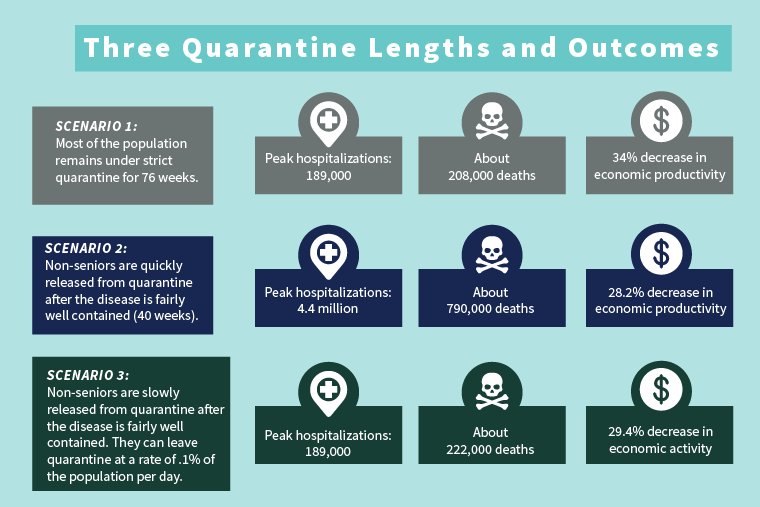As the carnage wrought by the coronavirus pandemic has abated in many countries around the world, attempts have been made to re-open economies and return to a semblance of normality from the peculiarities of life under lockdown conditions.
New research from Washington University in St. Louis urges officials not to rush to re-open too quickly for fear that the virus could rebound more severely than before. The researchers outline three distinct quarantine scenarios, with the most effective being one of strict self-quarantine for elderly people until such time as the number of new infections declines dramatically, with the quarantine then loosened for the rest of the population. This approach provides the best outcomes in terms of both health and the economy.

A key outcome from the modelling is that the different scenarios produce a different hospitalization population, with the worse case (scenario 2) significantly higher than the other two scenarios.
Until a vaccine
The team were striving to understand the best way to keep people, and the economy, safe until a vaccine is developed, which the team assumed was 76 weeks. Their work began with a Susceptible, Exposed, Infectious, Recovered (SEIR) model that is commonly used to predict the spread of infections.
These models typically divide people into one of four compartments: those who are susceptible, exposed, infectious, or recovered. Data was sourced from a wide range of peer-reviewed sources, to give them a full picture of the pandemic. The researchers divided the population into seniors/non-seniors, and those able to work from home normally and those largely unable to do so.
“And then we added something very important,” the researchers explain. “A large fraction of the population is asymptomatic. These people move a lot and are contagious, as opposed to ebola, for instance, where the sick are easy to spot and isolate.”
Factoring in all asymptomatic carriers
The models attempted to incorporate the asymptomatic carriers by varying the contagiousness of such people so that they mirror the public health measures and individual behavioral changes as the severity of the pandemic changes.
The models produce three different approaches to ending the lockdown, and the impact each might have on both the healthcare systems and the economy of a country.
The scenarios suggest that while reopening businesses and public spaces can provide a real boost for a short time, they are hugely damaging in the long run. This was common across all three scenarios, all of which had a number of constants.
For instance, in each of the scenarios, 85% of nonseniors are quarantined; no restrictions are loosened for the first 40 weeks; and a vaccine is available after 76 weeks.
Different approaches
The first scenario saw pretty restrictive quarantine measures kept in place for 76 weeks, which resulted in a sharp decline in economic activity, and a death toll of around 200,000 people. In the second scenario, quarantine measures were in place for just 40 weeks, after which any non-seniors were expected to return to business as usual. This scenario saw a rapid economic recovery, but also a second wave of infections that required quarantine measures to be reintroduced. This then undid any economic gains achieved by the earlier lifting of restrictions. It also saw 700,000 deaths recorded.
The final scenario was similar to the second, but instead of requiring all non-seniors to return to business as usual, a more gradual return was instigated, with 0.1% of non-seniors returning per day. This resulted in a slower, yet steadier return of economic health, with 220,000 deaths, all of which were restricted to a single wave.
The researchers believe that the inclusion of asymptomatic people was significant, as this highlighted how public health measures needed to be aimed at everyone rather than those supposedly in highest risk. It’s also important to note that none of the scenarios produced a positive outcome, and all were instead dealing with a least bad scenario.
“Our research on modeling COVID-19 spread and the economy shows that it is critical to open the markets gradually while continuing the quarantine of seniors,” the researchers say.
This may result in restrictions being lifted for some industries at a time, or gradually letting lower-risk people gather in one place.
“If policymakers prioritize short-term economic productivity more, their quarantine policies may lead to many times more deaths and hospitalizations with minimal short-term economic gain,” the researchers conclude.